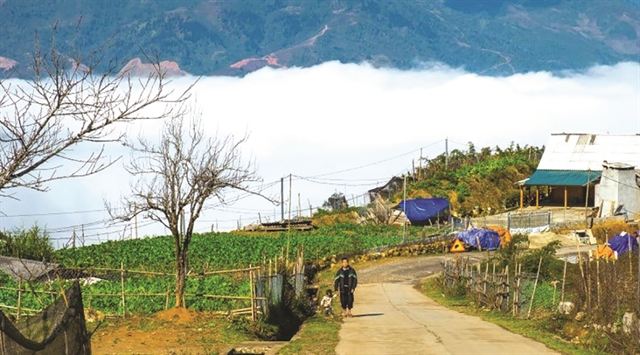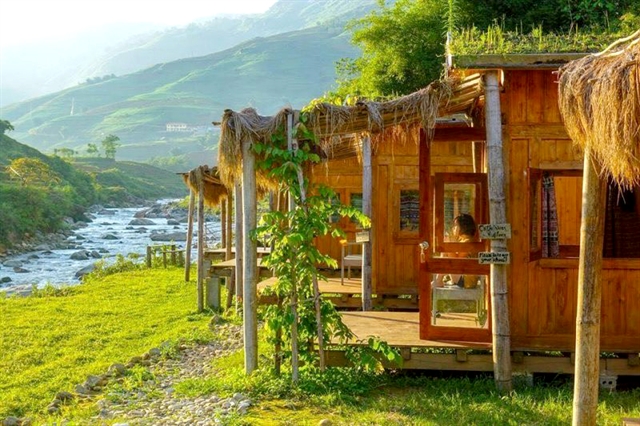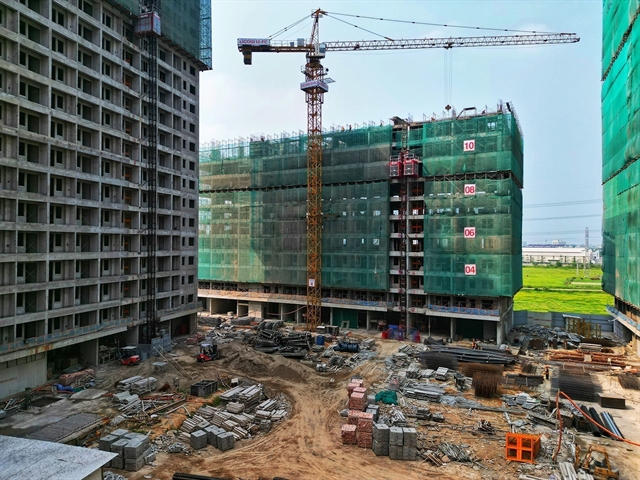 Travel
Travel

Hầu Thào Commune in Sa Pa District hides itself in blankets of white soft clouds, among pristine forest and mountains with lush green terrace rice field.
Trần Hoàng Nam
Hầu Thào Commune in Sa Pa District hides inside blankets of soft, white clouds, among pristine forest and mountains with lush green terraced rice fields.
The outskirts of Sa Pa town, however, have a different atmosphere in comparison to Sa Pa, the bustling tourism hotspot of the north – deserted and tranquil.
The area is populated mostly by ethnic Mông, who lead simple lives. The place is an ideal destination for cloud hunters and trekkers.
According to Lương Ngọc Khoa, a local guide, one can reach the commune from Sa Pa, passing Ý Linh Hồ, Lao Chải Sàn, to Tả Van Village, passing a bamboo forest, then reach Sử Pán before finding their way to Hầu Thào. The total route is about 25km.

|
| The simple natural landscape of Hầu Thào: Photo ximgo.com |
Before the pandemic, many foreigners liked to experience this route, Khoa says.
“This is a spectacular route, along which visitors can explore many beautiful spots.”
“You can easily find many foreigners posting photos of the place on Instagram,” Khoa says, showing photos of some of his foreign friends on his Instagram.

|
| A couple takes a wedding photo on the way to Hang Đá Village. Photo bui quyet.com |
If Sa Pa impresses visitors with stable houses, luxurious hotels and resorts, Hầu Thào Commune wins people’s hearts with simple, small houses.
“The very rough houses of the Mông people add more charm to the natural beauty of the mountains, terraced fields and valleys,” says Lê Tuấn Anh, a visitor from Hà Nội. “Local nature is still beautiful though the life and tourism service here is still under-developed.”
If one has a lot of free time, they could spend the whole day wandering around the villages in the commune.
“Here and there, you will encounter wood houses with smoke billowing into the sky in the late afternoon, when people are preparing their dinner,” Anh says.
The innocent laughter of children will remind you that this is real life, not a painting, he adds.
“Sa Pa is beautiful in the early morning fog, yet Hầu Thào is even more mysterious as it’s more tranquil than anywhere else,” Khoa says.
For cloud hunters
Hang Đá Village in Hầu Trư Ngài, Hầu Thào Commune at dawn is considered one of the best places for cloud hunters.

|
| The area is most suitable for nature lovers, who want to stay away from busy traffic. Photo liberzy.com |
“Not many people have reached Hang Đá Village,” Khoa says. “But just come here once and you will never forget the spectacular mountains embraced by layers of thick white clouds,’’ Khoa says.
To see the commune in the early morning, one must spend the night at a nearby house.
Sunset is another spectacular moment for tourists when the scenery is overwhelmed with bright orange light. It is both romantic and relaxing.
To reach Hang Đá Village, from Sa Pa, one should go toward Tả Van Village for some 3km. At the junction, one should take the way to Resort Sa Pa Jade Hill. From there it is 3km more.
Khoa says that in order to see the clouds if the previous day was rainy and the next day is sunny, there is a 95 per cent chance it will be a very cloudy day.
“Lào Cai has mild temperatures all year round,” Khoa says. “You can visit the province any time of the year. But if you want to see clouds, you should choose the later months.”
There are almost no hotels in Hầu Thào except the recently opened Utopia Eco Lodge, which offers a full service.

|
| Utopia Eco Lodge by a stream. Photo ximgo.com |
The resort offers fairly calm experiences of sunrise and sunset, with a view of the terrace rice fields and bamboo forest.
Around Hang Đá Village, other destinations for cloud hunters include Hàm Rồng Mountain, Fansipan Peak, Mường Hoa Valley, Ô Quý Hồ Pass and Sâu Chua Village.
Mường Hoa Valley
The valley is 8km to the southeast of Sa Pa Town.
A highlight of the valley is the ancient rocks, scattered here and there on fields. There are many figures carved into them assumed to be made by early humans.
The stone area has been listed among the National Heritage Sites because of its mysterious carving patterns. VNS









